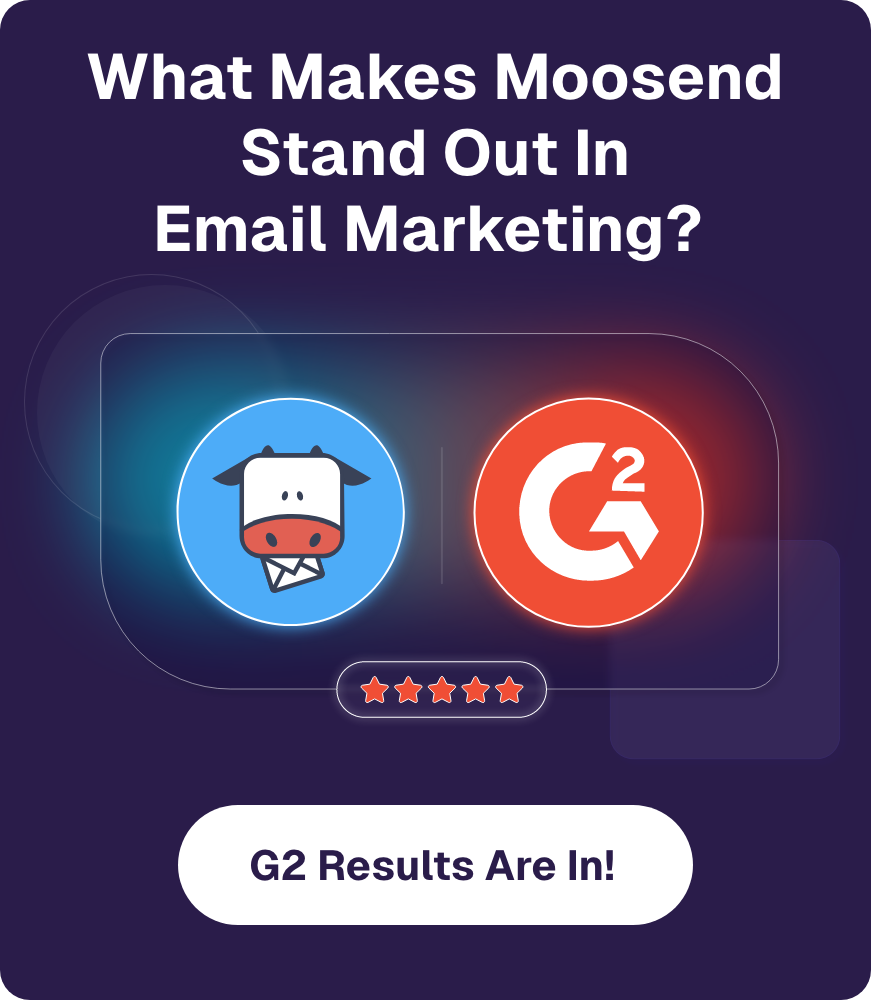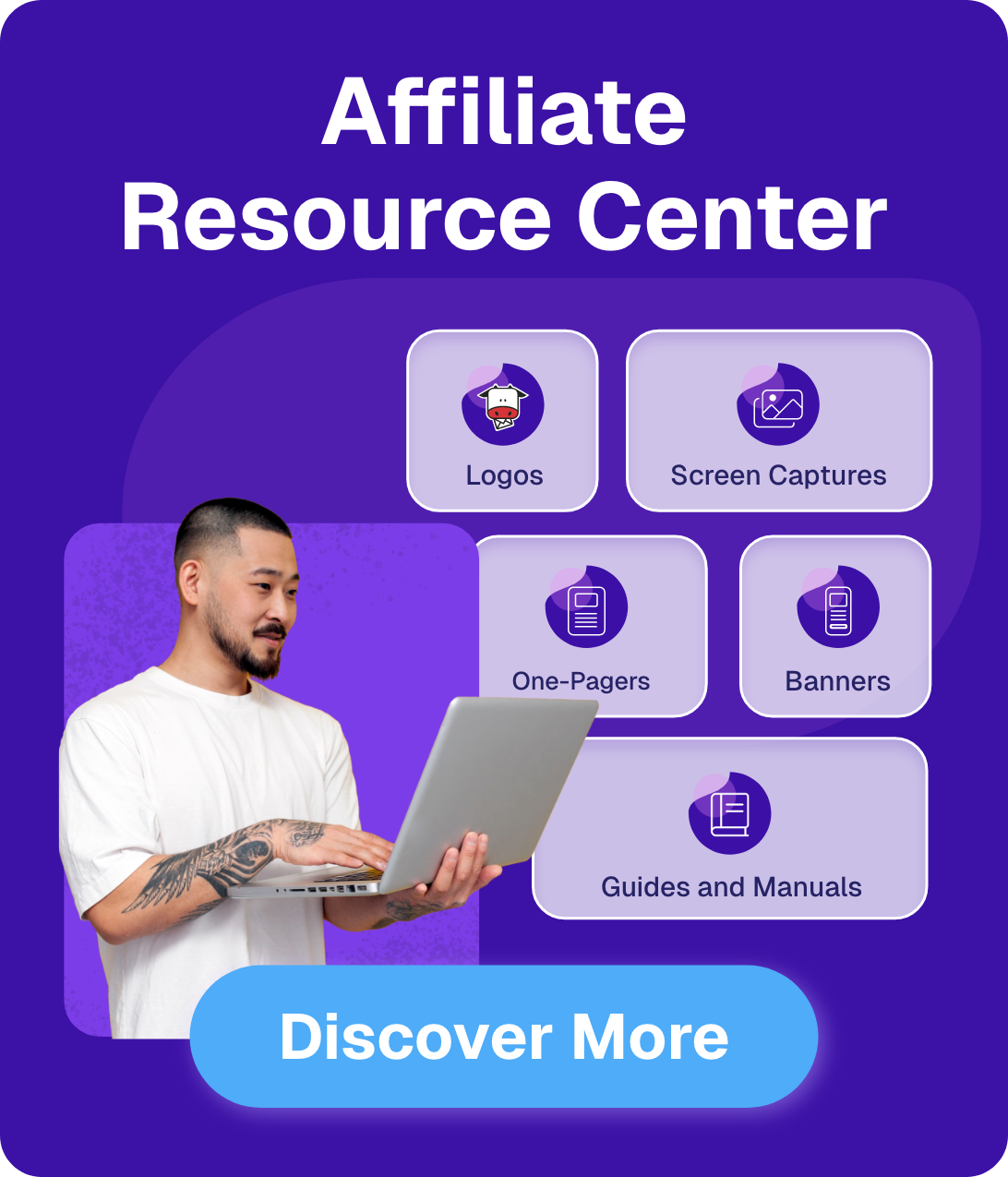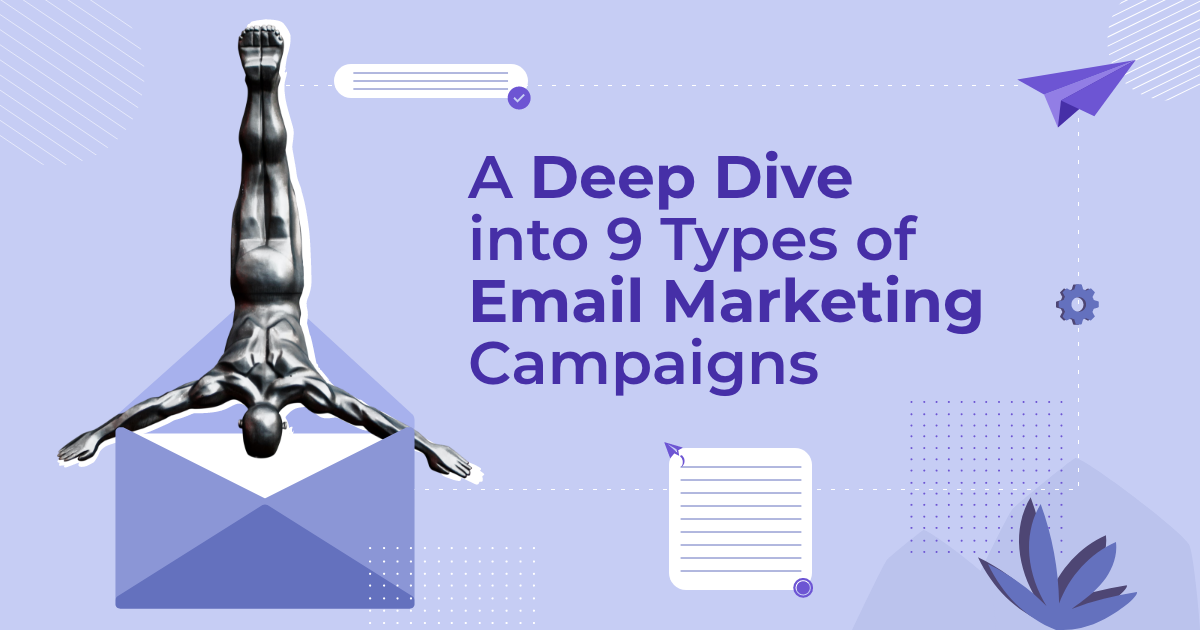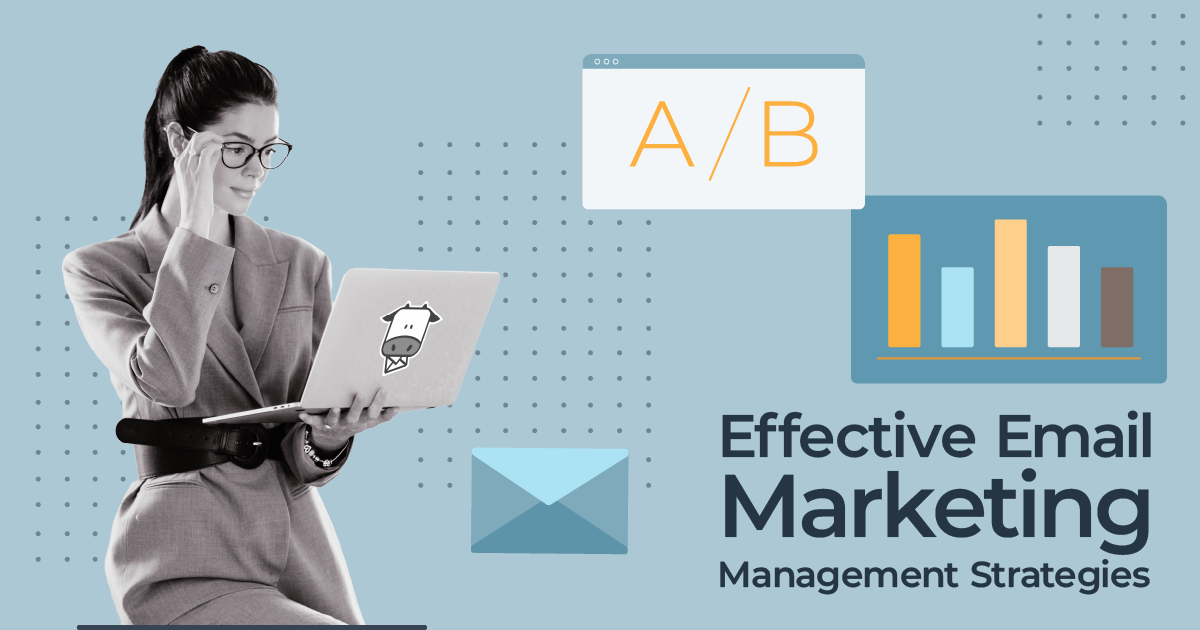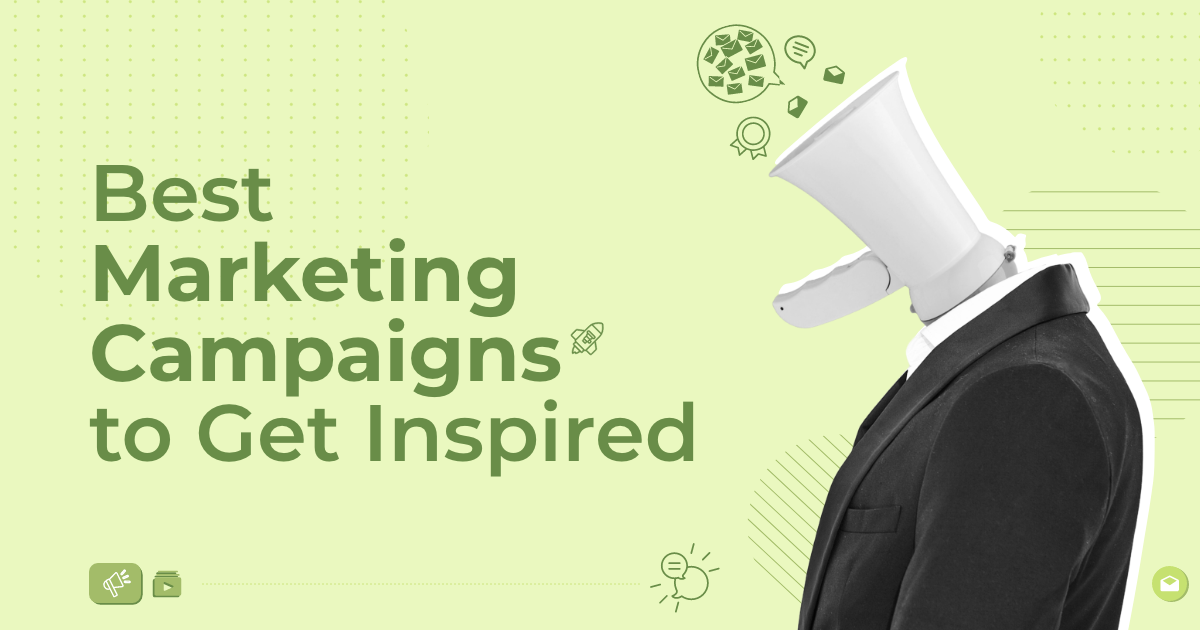
13 Essential Email Types Every Marketer Should Master [2025]
Sending the same email marketing campaign over and over is like serving up plain toast every morning. Sure, it’s alright, but wouldn’t you rather have a hearty breakfast instead?
Diversifying your campaigns will help you make your strategy more flavorful and satisfying for your recipients, resulting in better click-through rates (CTR) and conversions.
If you’re looking for fresh ideas to up your email marketing game and expand your audience, you’re in the right place.
In this guide, we’ll show you different email types to enhance your email marketing strategy and engage your subscribers, from transactional and promotional emails to lead nurturing messages.
Transactional Emails
Transactional or triggered emails are messages brands send to recipients only if they have initiated an interaction.
For instance, you can send transactional emails to confirm an email subscription or update a customer on their order.
They’re a great opportunity to welcome new subscribers, keep them updated about their orders, build trust, and nurture a strong relationship with your audience.
1. Welcome email campaigns
Businesses usually send standalone emails or extended sequences to welcome new subscribers and introduce them to their brand, new product, or service.
Here’s an example from The Body Shop:
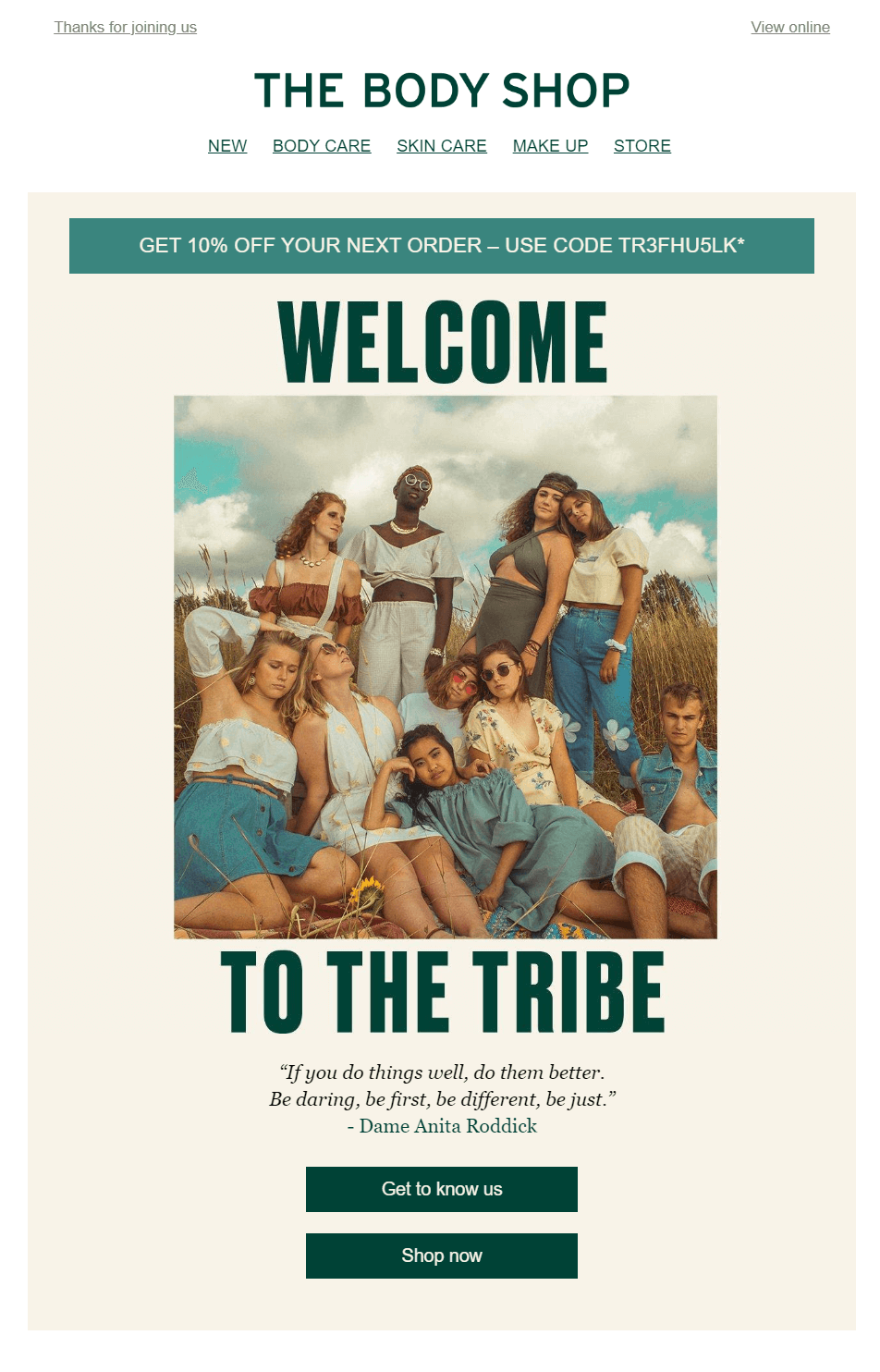
Usually, a welcome message is the first email someone expects to receive after downloading a lead magnet, signing up for an account, or subscribing to your newsletter.
Moreover, this type of email has an impressive click-to-conversion rate of 56.75%, making it the most effective email sequence followed by abandoned cart and back in stock campaigns.
What to consider:
- Personalization: Tailoring relevant content to each recipient creates a more engaging experience. To achieve this goal, consider segmenting your audience into relevant groups.
- Clear communication: Since a welcome series of emails marks the beginning of an ongoing conversation, set expectations regarding email frequency and content.
- Email content: Deliver brief, valuable email messages to save time and ensure engagement.
Further reading: For more inspiration, check out our top welcome email examples compilation and welcome email copy templates.
If you’re planning to create a welcome campaign like those of well-known brands like The Body Shop, many email service providers offer a range of pre-made templates and workflow recipes to help you save time. You can find your ESP’s welcome email series, customize the triggers and actions and then launch your welcome campaign.
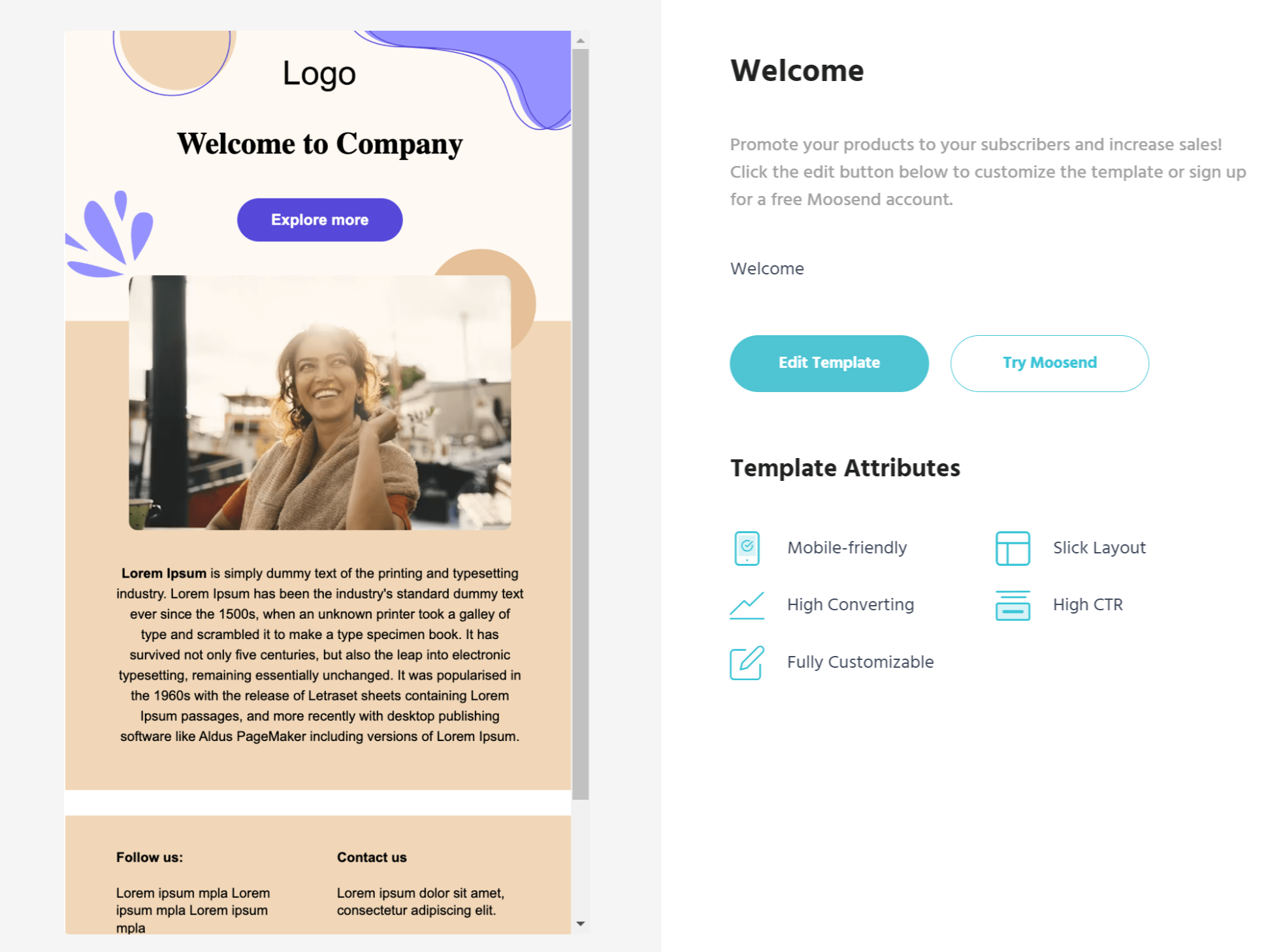
2. Confirmation emails
Marketers send confirmation emails to subscribers and customers to confirm actions or transactions they have completed.
Confirmation emails are a top-performing campaign in your email marketing toolbox, as they usually see high engagement rates. In the retail industry, for instance, average CTR rates reach 2.58%.
Here’s an order summary from Audible:
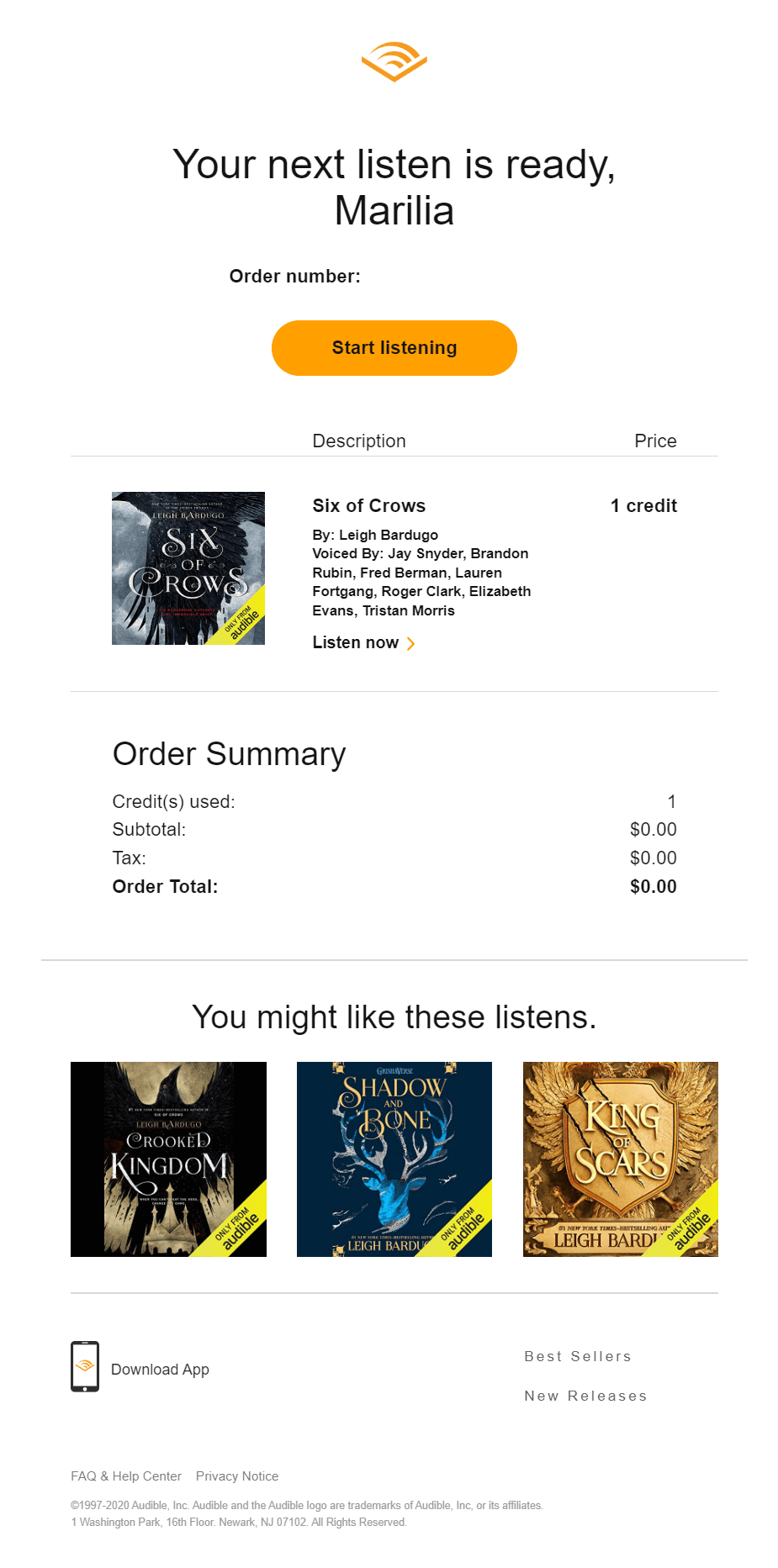
Other common types include:
- Order confirmation emails
- Appointment confirmation
- Upcoming event registration
- Subscription confirmation
- Booking confirmation
- Cancellation confirmation
Since this type of transactional email has such high open rates, they’re a great place to include important info and calls to action (CTAs), such as links to explore your website, incentives to join loyalty programs, or subscribe to your newsletters
What to consider:
- Short and straightforward: After your greeting, provide a short, clear explanation of the purpose of your email.
- Customer support details: Help your confirmation emails stand out by making it easy for subscribers or customers to ask for help.
- Compelling CTA: Depending on the type of confirmation email, use it strategically to invite your customers to follow you on social media, refer friends, or cross-sell and upsell where appropriate.
3. Abandoned cart campaigns
When your customers add items to their online shopping cart but don’t complete the purchase, send them an abandonment cart email or, a sequence to nudge them to complete the purchase.
With the average shopping cart abandonment rate reaching up to 70.19%, it’s necessary to craft the perfect recovery email.
Here’s how this type of email looks like:
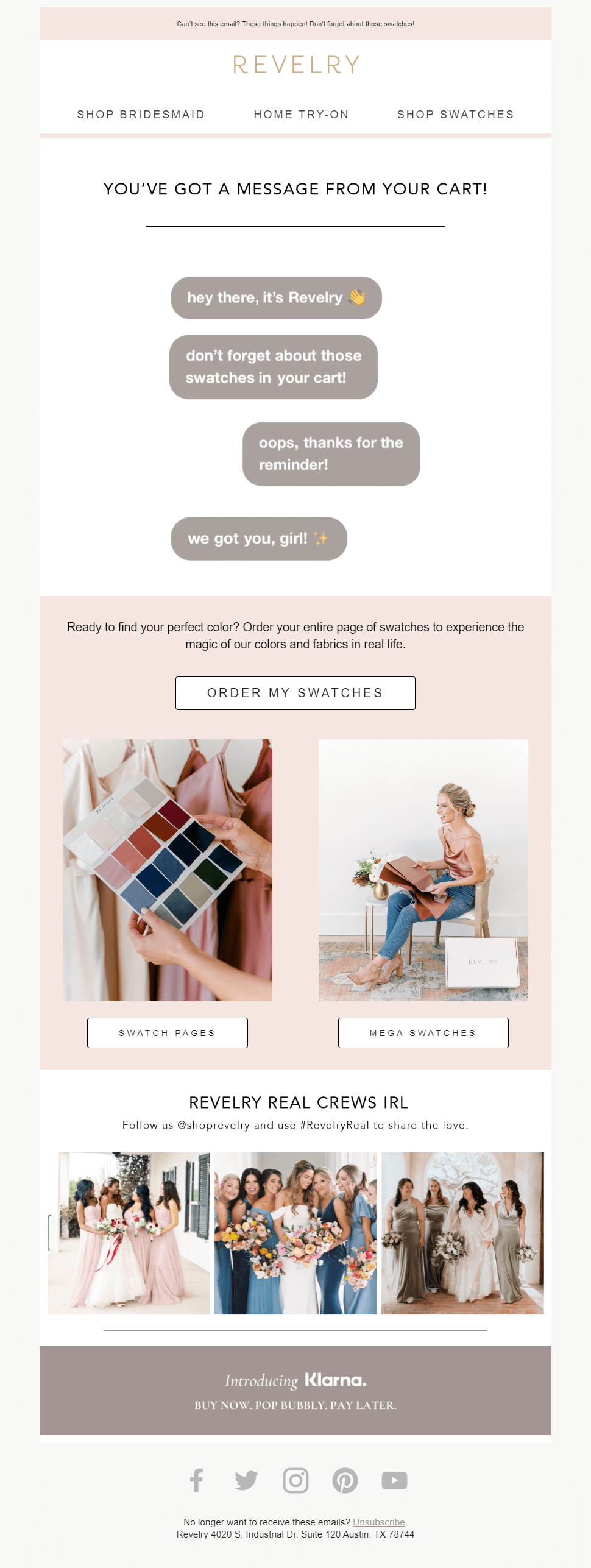
Abandoned cart emails are some of the most important marketing tools that eCommerce businesses use to recover their lost sales. However, you can use this email type to your benefit regardless of your niche. Just keep the following in mind.
What to consider:
- Show them their carts: Remind your customers about the items still in the cart and encourage them to complete the purchase. Don’t forget to include social proof, a sense of urgency, and a strong CTA. Also, a discount will also encourage shoppers to return to their abandoned carts.
- Follow up: Don’t only send one email. Follow up with a similar email or create an abandonment cart sequence.
- Offer support: If your customers can easily get answers or help, your chances of making a sale might increase.
As they say, when the door closes, a window opens, and with 50% of abandoned cart emails getting opened, and 21% of them receiving click-throughs, these sequences are your chance to win your customers back.
You can easily set up your cart recovery sequences using Moosend’s advanced automation builder. Choose the steps and appropriate time intervals and then deliver your message at the right time.
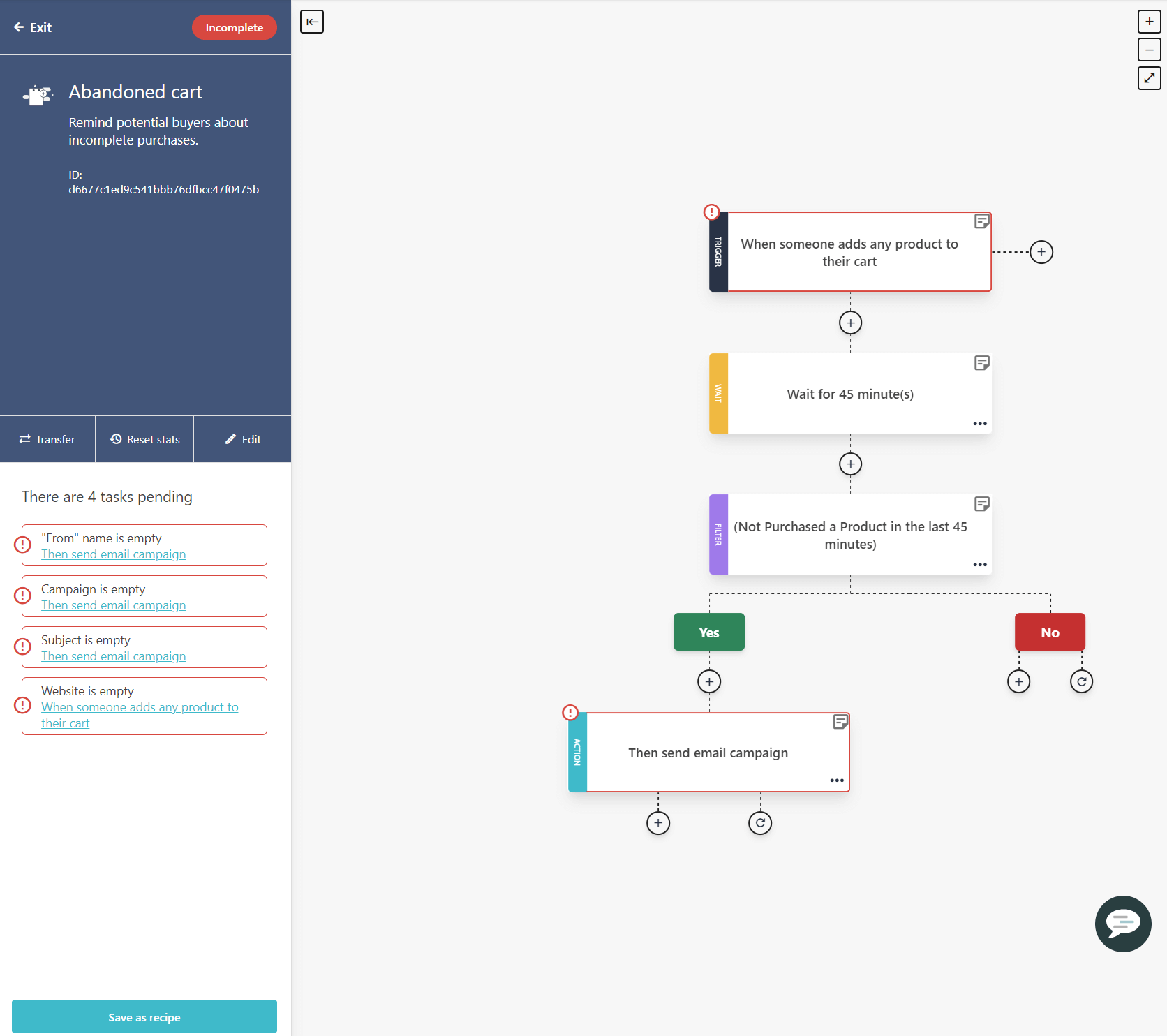
Build your abandoned cart series
4. Upsell or cross-sell emails
The key difference between cross-sell and upsell emails is their focus on the customer’s buying journey.
Cross-sell emails suggest additional products to complement the purchases the customer has already made, while upsell emails offer upgrades or more premium purchases.
Here’s a cross-sell email example by the Dollar Shave Club:
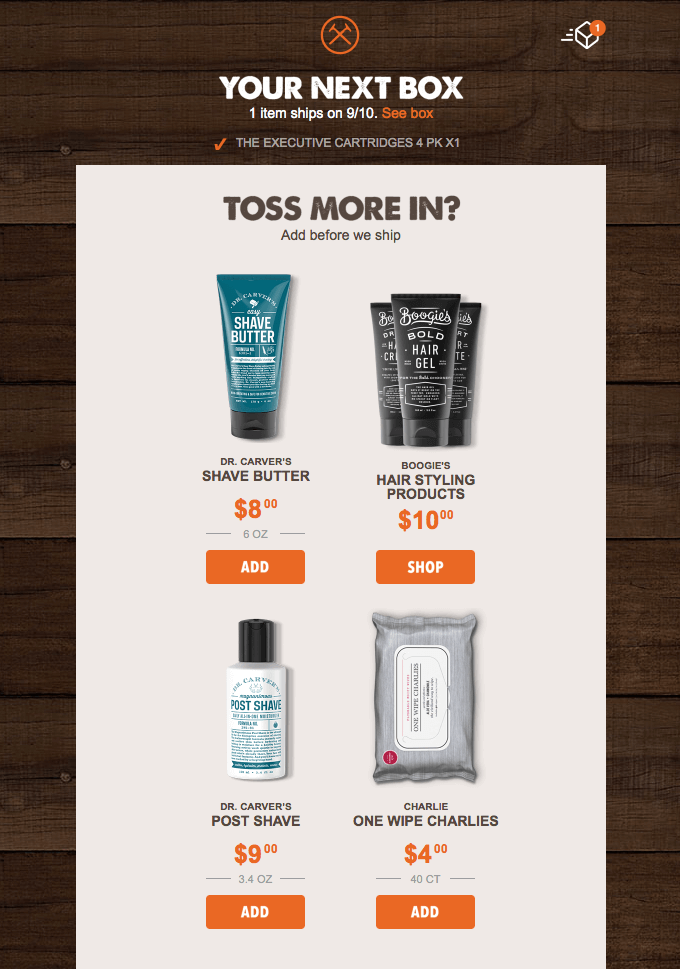
Retaining existing customers is a long-term strategy that’ll increase your lifetime value and loyalty. After all, these customers tend to spend more since they already know and trust your brand.
What to consider:
- Attractive offers: Offer products that complement what your customers have already bought, adding extra value and benefits. Also, sweeten the deal with tempting discounts, bundles, or exclusive promotions.
- Email list segmentation: Split your email list into smaller groups based on common traits like demographics, past purchases, or interests to increase CTR and conversion rates.
- Great timing: Send an email right after someone leaves your store, even if they haven’t bought anything yet.
5. Basic transactional email campaigns
Basic transactional emails include various types of emails sent to customers after specific interactions or transactions.
These messages typically also have high open and CTR rates as subscribers and customers expect them.
For example, password resets are some of the most common basic transactional emails, providing a link or instructions to create a new password.
Here’s an example by Sephora:
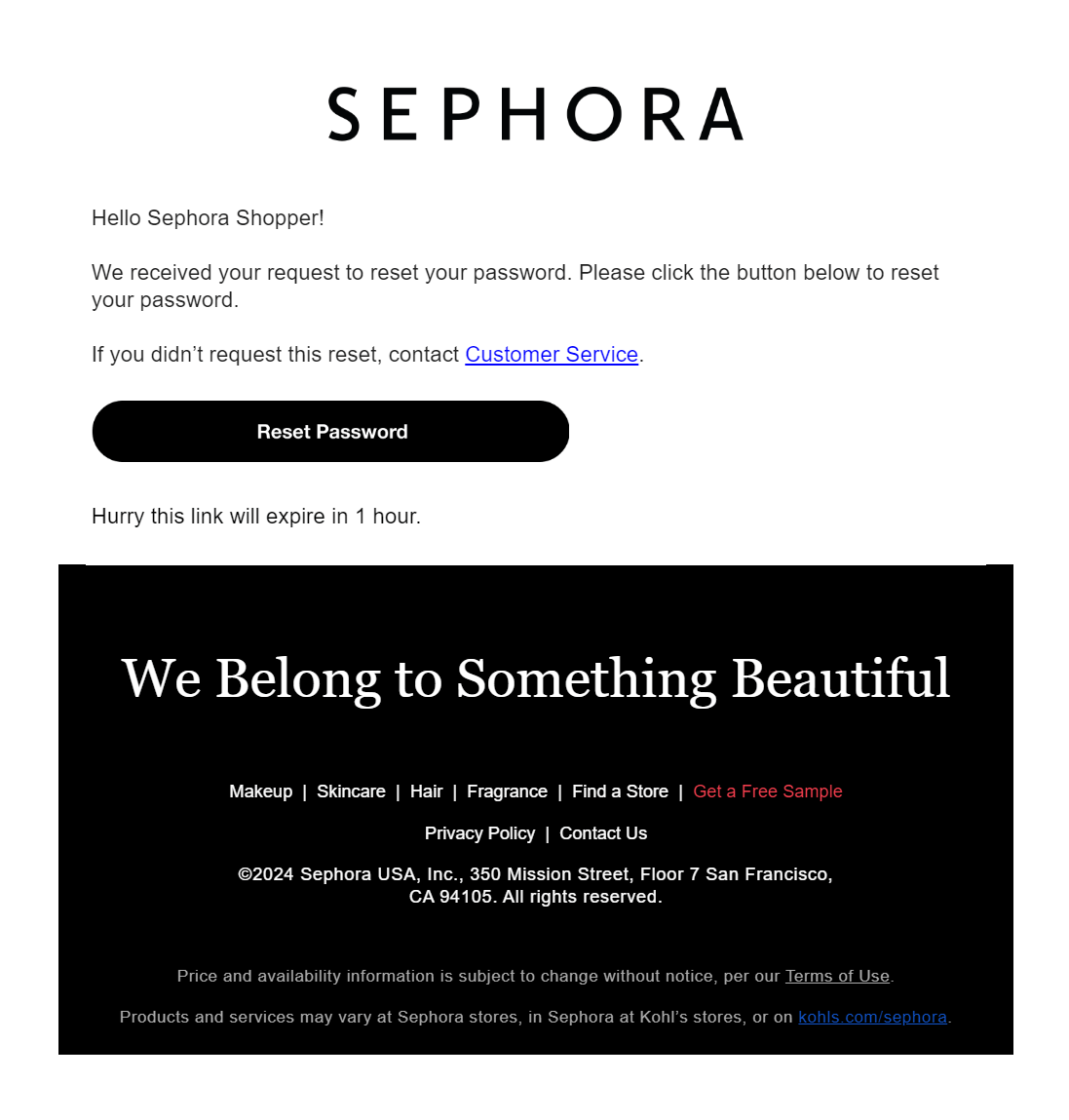
Below, you’ll find some more common basic transactional email types:
- Account creation: Sent when a customer creates a new account on a website or platform. It usually contains login information and instructions.
- Account renewal: Delivered to customers to prompt them to renew their accounts, ensuring continued service access.
- Unsubscribe: Sent to subscribers to confirm that they have successfully unsubscribed, usually asking if they did it by mistake or if they’d like to refine their subscription choices.
What to consider:
- Brief and on point: Optimize them for better customer experience and conversions.
- Re-engagement options: Highlight the positive aspects of your brand and encourage social sharing.
Promotional Emails
Promotional emails are marketing messages that prompt customers to act on special offers, events, products, and more.
They support businesses in increasing brand awareness, effectively connecting with their audience, and boosting sales.
6. Newsletter emails
Newsletter emails are recurring emails that deliver curated content, updates, news, or promotions to subscribers.
While newsletters include promotional elements, their primary goal is usually to engage subscribers, provide valuable information, and keep the audience in the loop and connected to the brand.
Here’s a beautiful newsletter example by SoYoung:
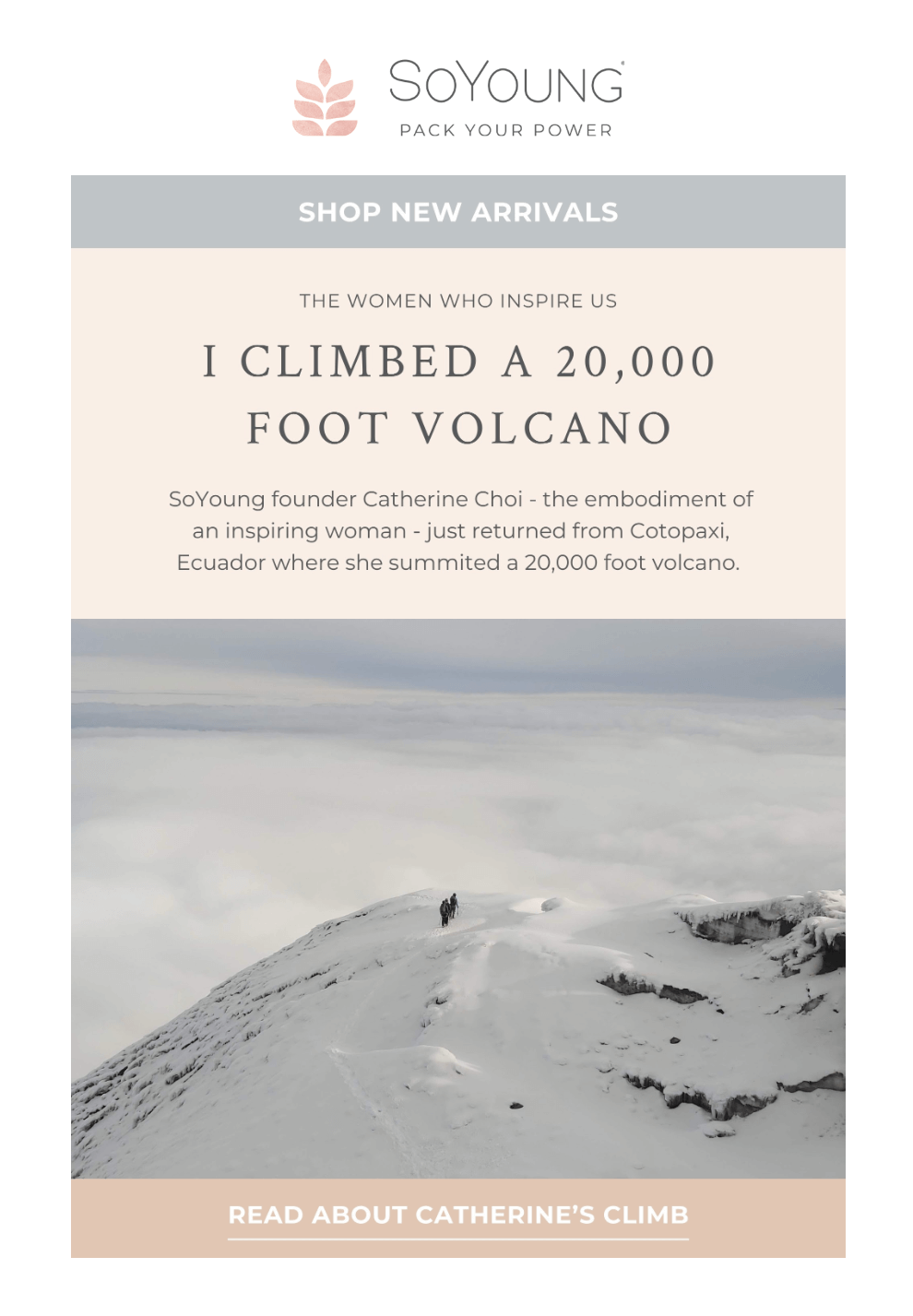
These emails often include giveaways, industry news, tips, how-tos, blog posts, contests, or curated content.
What to consider:
- Newsletter content: The rule of thumb is to keep your email content 90% educational and 10% promotional.
- Visual elements: Email design and images sometimes speak louder than words. Make sure you add high-quality and relevant visuals to increase engagement.
- Newsletter test: Before sending the full campaign, check for spelling, broken links, and spammy words. Then, send a test email to ensure it’s mobile-friendly and well-received by a few recipients.
Creating great newsletters isn’t rocket science; however, here’s our dedicated newsletter checklist to help you simplify the creation process. If you want a hand, Moosend’s template library can also save the day.
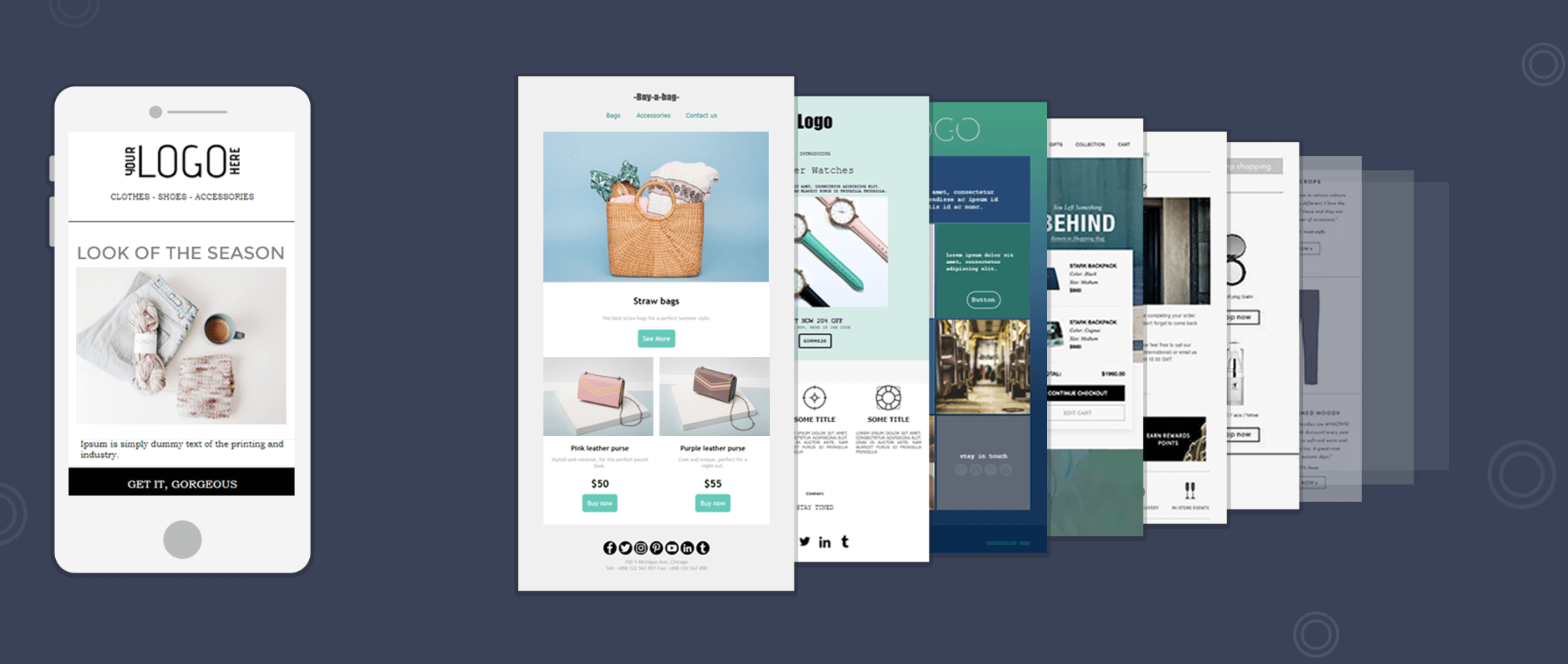
7. Lead nurturing campaigns
Lead nurturing email campaigns are designed to guide potential customers through the sales funnel by providing them with relevant and valuable information tailored to their needs, interests, and the buyer journey points they’re at.
Heres’s an example by Caudalie:
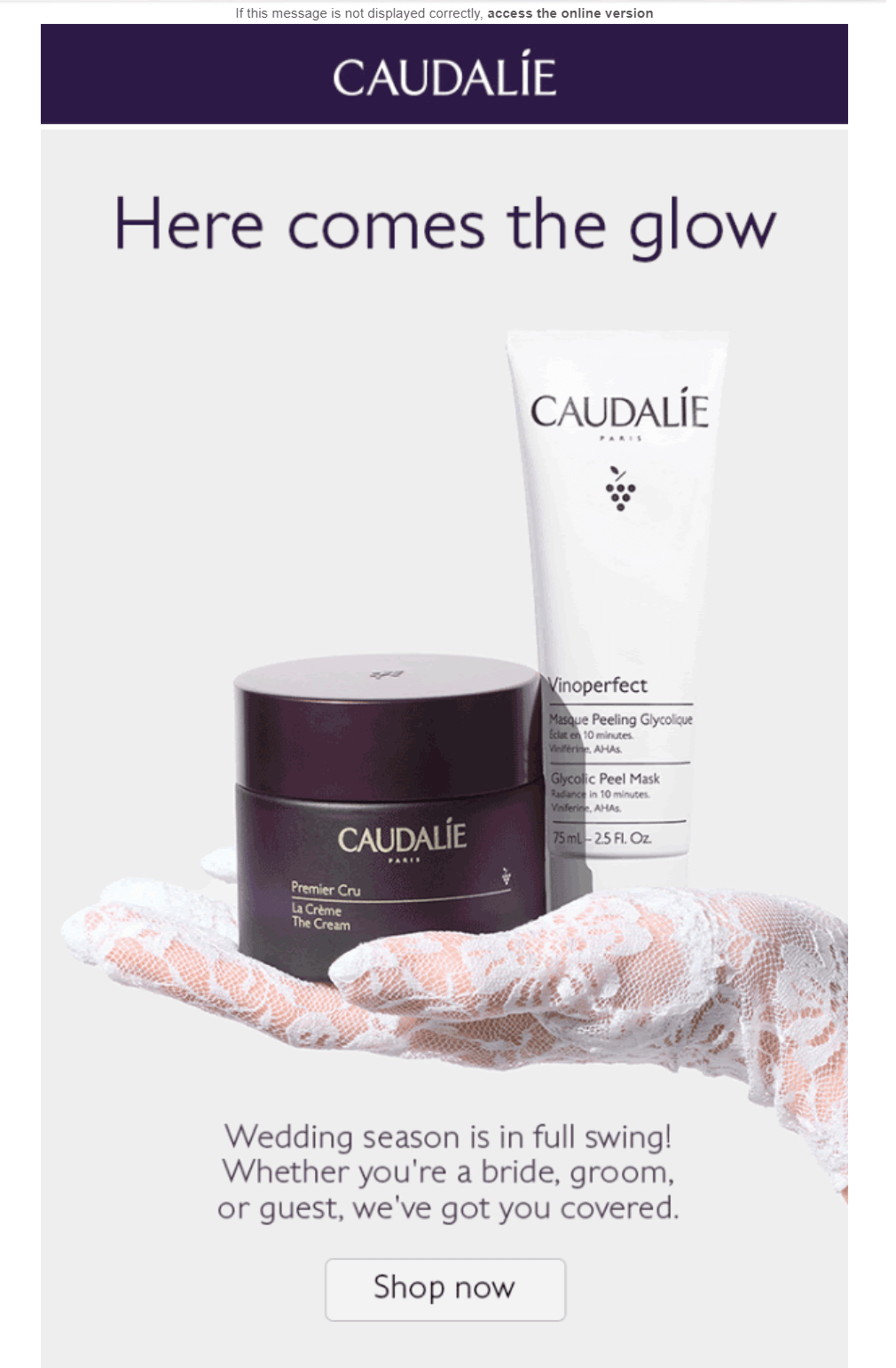
What to consider:
- Valuable content: Educate your leads, share tips, and debunk myths; your subscribers will appreciate your emails and stay engaged until they’re ready to buy.
- Focused message: Show appreciation for your lead’s time while increasing the chances they’ll read and act on your message takeaways. Also, stick to one clear call to action for better results.
- Minding the flow: Remember, your lead nurturing campaign aims to steer subscribers toward a purchase gently. Thus, design your campaign to progress toward this goal steadily.
8. Announcement emails
Another great email type you need is announcement emails. These are marketing messages that inform subscribers and customers about important news, updates, or events related to the business, products, or services.
Hence, they help businesses share important information and nurture transparency. Here’s an example by Modern Milk:
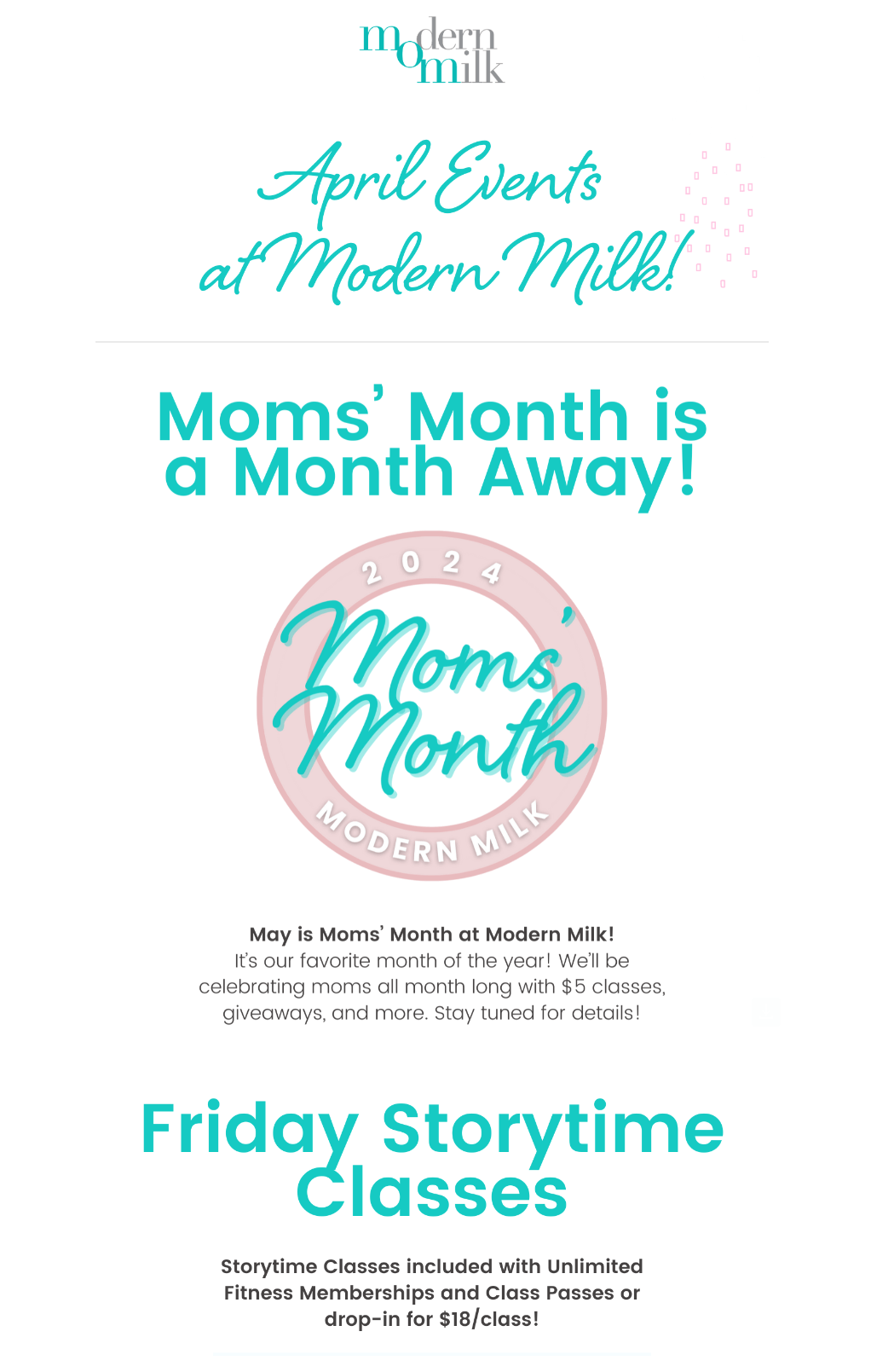
Moreover, announcement emails can include onsite and online invitations.
Onsite invitations in email marketing prompt action on a website or landing page. Examples include event registrations, webinar sign-ups, or product demos with direct trial sign-up links.
Online invitations are similar, except that they include external links that direct recipients to a third-party website or platform.
What to consider:
- Timing: Especially if you’re planning a sequence, make sure to follow up with your audience a few times before the event.
- Guidance: Include all relevant information, instructions, and guidelines in your announcement emails, along with a clear CTA.
- Recipient gains: Explain the benefits of what you’re informing your recipients about.
If you want to start promoting your onsite or online events, you can grab an event template like the one below and get started. Using pre-made design will save you time and allow you to focus on more pressing tasks.
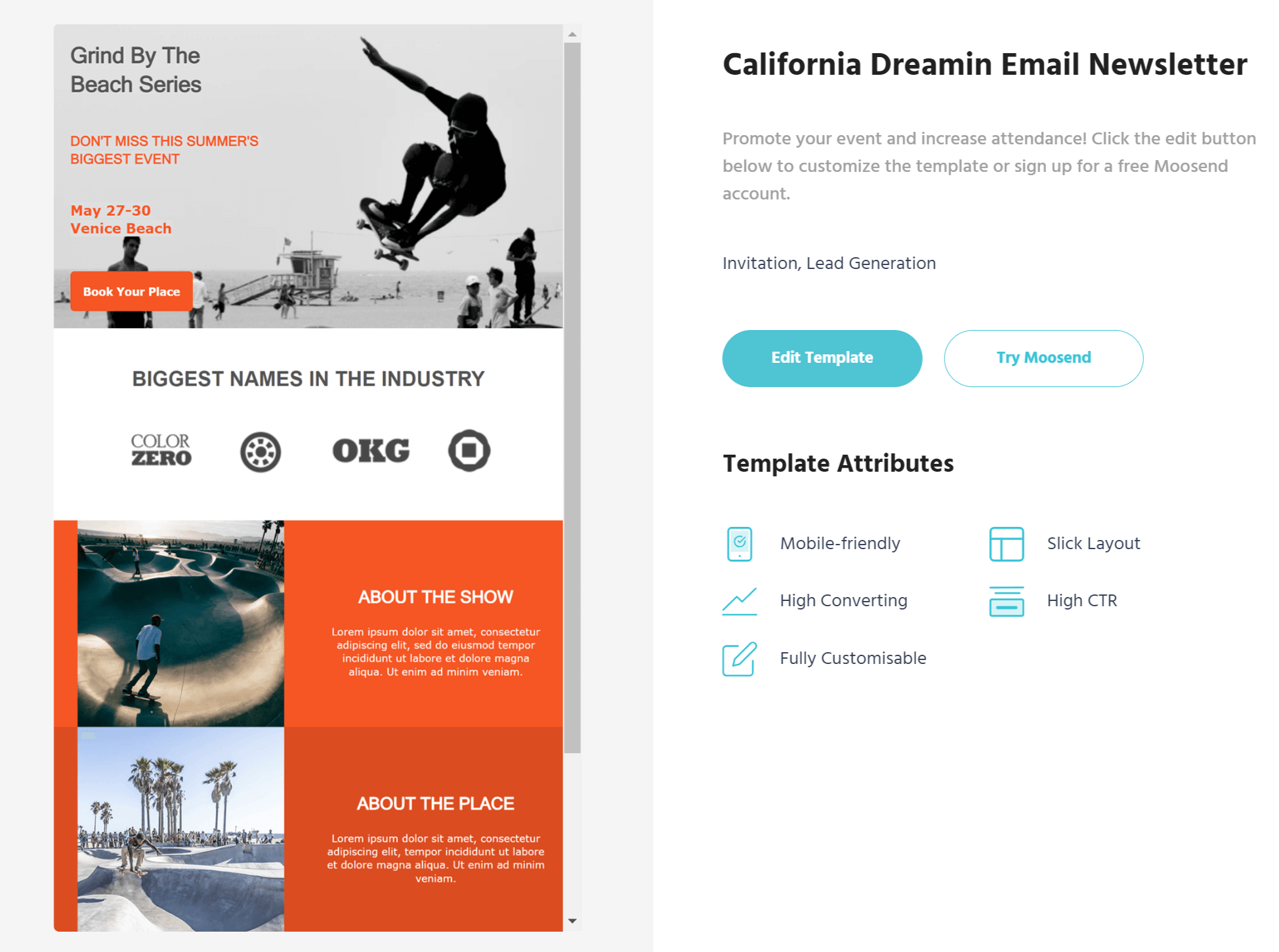
9. Offer email campaigns
Offer emails are promotional emails with a narrower focus, delivering special deals, discounts, promotions, or exclusive offers to customers. We could say that this type of email is the bread and butter of eCommerce stores.
Here’s how American Giant does it:
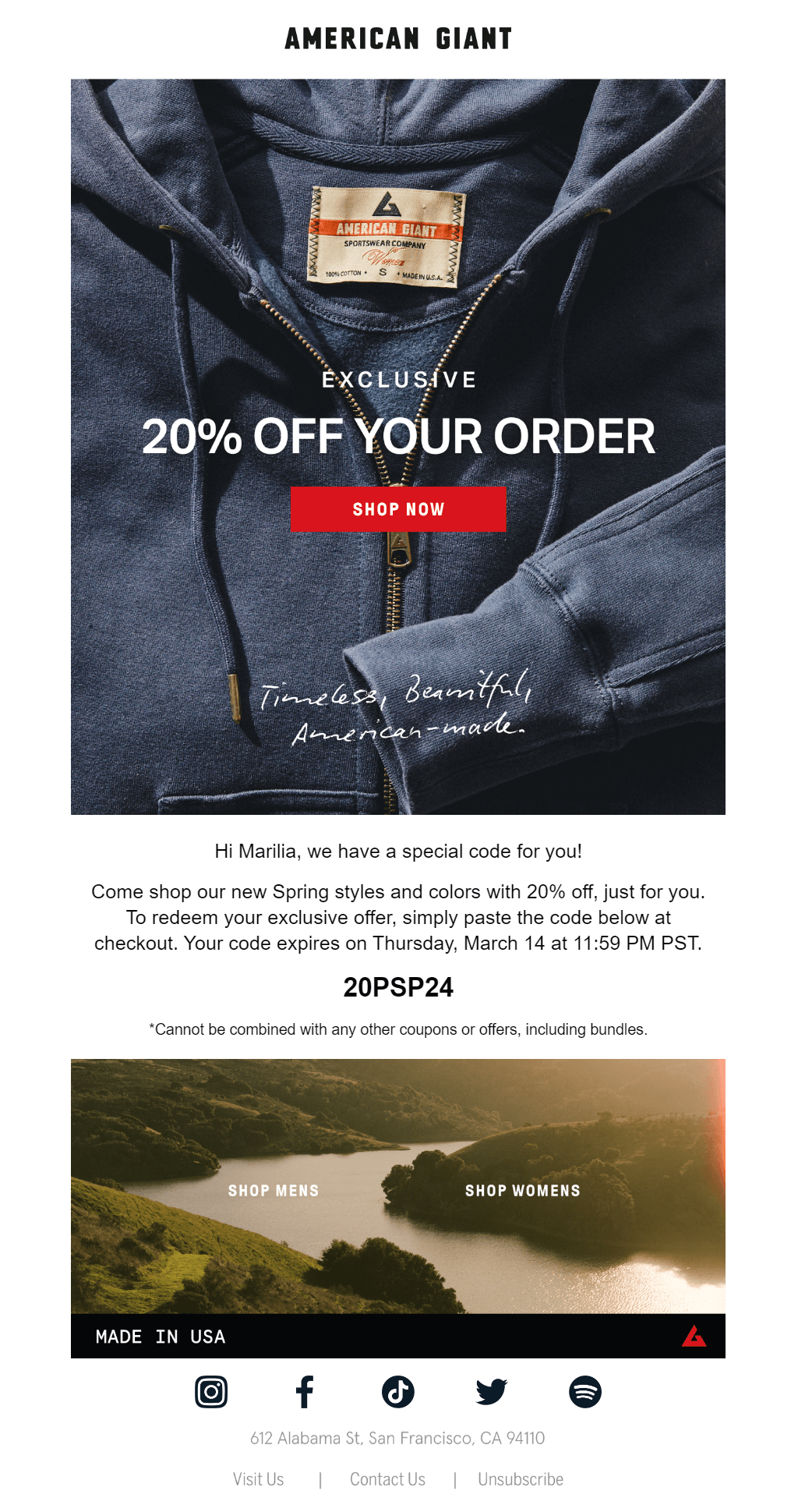
The purpose of offer emails is to help drive sales and increase profits.
What to consider:
- Audience segmentation: Your approach to new customers in your offer emails should differ from how you address existing customers for repeat business. Segment your list to tailor your messaging effectively to each group.
- Valuable offer: Start with a compelling email subject line to entice the recipient. Then, use your email copy to build on it, showcasing what the subscriber gains by clicking on the CTA.
- Eye-catching design: Make sure you use the right visuals, email fonts, and color palette to make your campaign eye-pleasing. If you want a more personal feel, you can always create a plain text email that will appear to have been sent from your personal email account.
Remember, whatever incentive you choose for the offer should be the icing on the cake, not the sole reason they decide to purchase.
10. Re-engagement emails
Companies send re-targeting emails to inactive or dormant customers and subscribers to rekindle their interest and encourage them to re-engage with a brand.
This is an important email type because unopened emails can harm your sender reputation, reduce open rates, and negatively affect email deliverability.
Here’s a great example by Penguin Books:
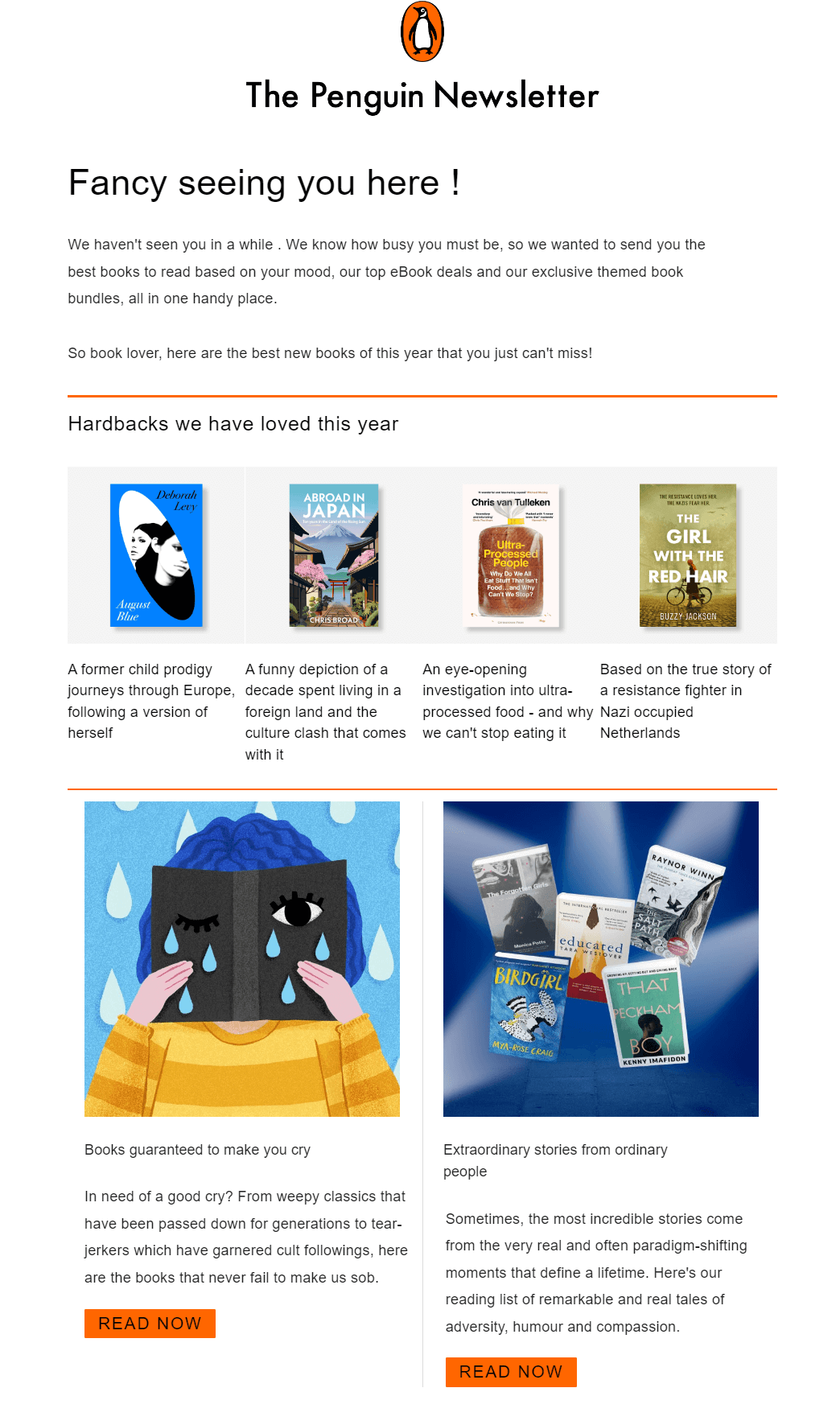
Usually, re-engagement emails acknowledge recipients’ inactivity and include incentives, updates, or reminders to interest them in a brand again.
Other email types, like back-in-stock emails, can reignite subscriber interest in your brand, encouraging engagement and purchases.
What to consider:
- Compelling subject lines: Re-engaging inactive email subscribers can be challenging. Catch their attention right away with a subject line that communicates value at first glance.
- Emotional elements: Gently remind them of the problems you helped them solve, and if they’ve missed updates, they might want to see what’s been happening.
- Reasons for re-engagement: Offer them a discount, coupon code, exclusivity, or another incentive to encourage them to interact with your brand again.
Email deliverability is one of the most important email metrics you need to monitor as it determines whether your emails reach your recipients’ inbox or not. Choosing the right email service provider and following email delivery best practices is the best way to ensure low bounce rates.
Moosend has recently been tested by Email Tooltester along with other popular email tools. The test showed that it’s among the platforms that are least likely to be flagged as spam. If you want high delivery rates and low bounces you can sign up for the free trial and try the software.
Customer Relationship Building Emails
The main goal of any business is to cultivate brand ambassadors, encourage referrals, and build a loyal base of repeat buyers.
Customer relationship-building emails play a key role in making this happen.
11. Survey email campaigns
Surveys or polls are an excellent tool for gathering client feedback because they allow businesses to gather invaluable insights. Moreover, they can use the data to improve products and services and offer better customer experiences.
Here’s how a survey email looks like:
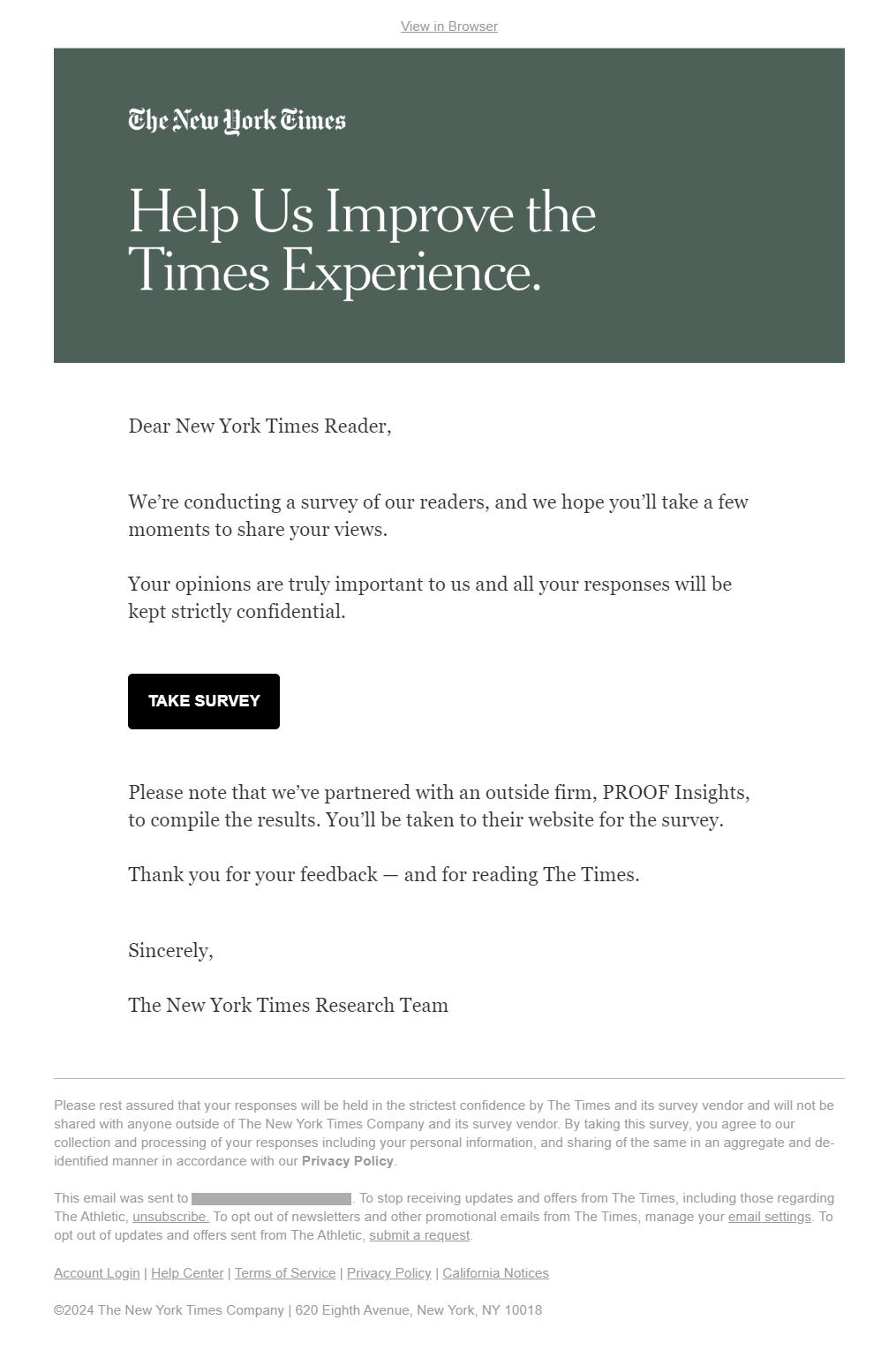
Simple email polls or questionnaires can provide businesses with valuable insights into client needs and preferences.
A Net Promoter Score (NPS) survey, which is a widely used method for measuring customer loyalty and satisfaction, is a great marketing tool every business should use.
Your emails may also include product feedback, customer stories, and testimonial request emails.
What to consider:
- Key insights: Save your recipients time and get the most responses by building your survey around the information you need the most.
- Participant rewards: Gently nudge your audience to complete the survey by offering them a limited-time discount, a sweepstake, or a free product in exchange for their time. You can communicate the benefit in your survey subject line.
- Estimated time: By managing your respondents’ expectations, you might avoid abandonment, get better-quality responses, and show you appreciate their time.
12. Milestone or anniversary emails
Milestone emails celebrate your customers’ key moments. These can include a variety of email types, like membership, subscription anniversaries, accomplishments, or other significant milestones or accomplishments.
Here’s an example from John’s Crazy Socks:
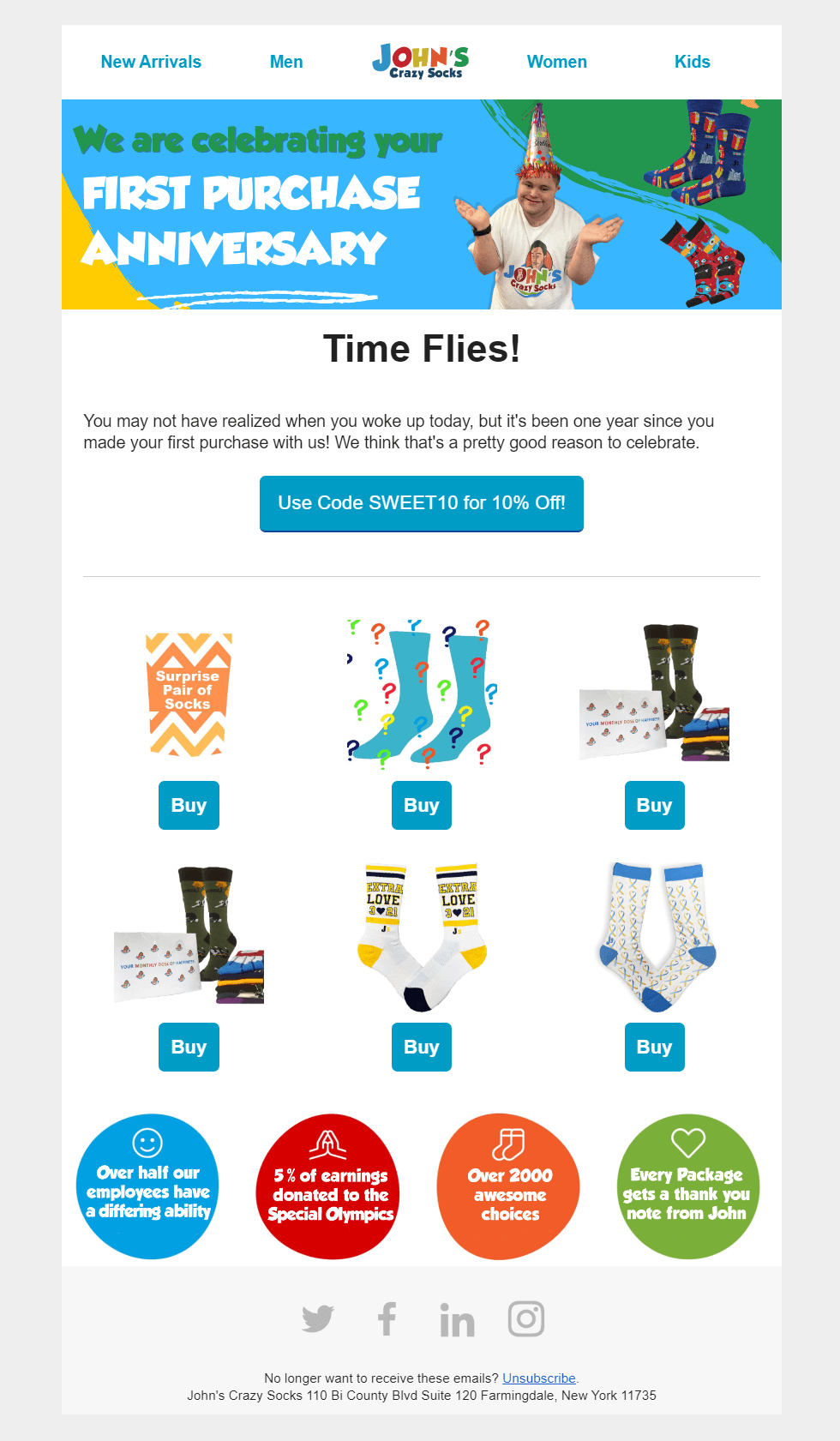
Milestone emails play a vital role in the customer experience. One of the reasons is that they don’t focus on promotions but on celebrating milestones.
Also, they might be the simplest and most enjoyable emails you send to your subscribers or customers.
What to consider:
- Relevancy: Apart from your subscriber’s or customer’s birthday, collect data according to your email marketing strategy. For instance, you could monitor their activity on your platform, their purchase history, and more.
- Incentives: Make your email unique by including a reward—a discount on their next month of service or a gift card, for example—in your milestone emails to express how much you appreciate them.
- Converting copy: From a snappy subject line to a compelling CTA, create an email copy that celebrates your subscribers and customers while reinforcing your brand and its value.
13. Loyalty program emails
Businesses send loyalty program emails to enrolled customers, providing them with updates on their points balance, exclusive offers, benefits, and rewards they can redeem.
Here’s an example by H&M:
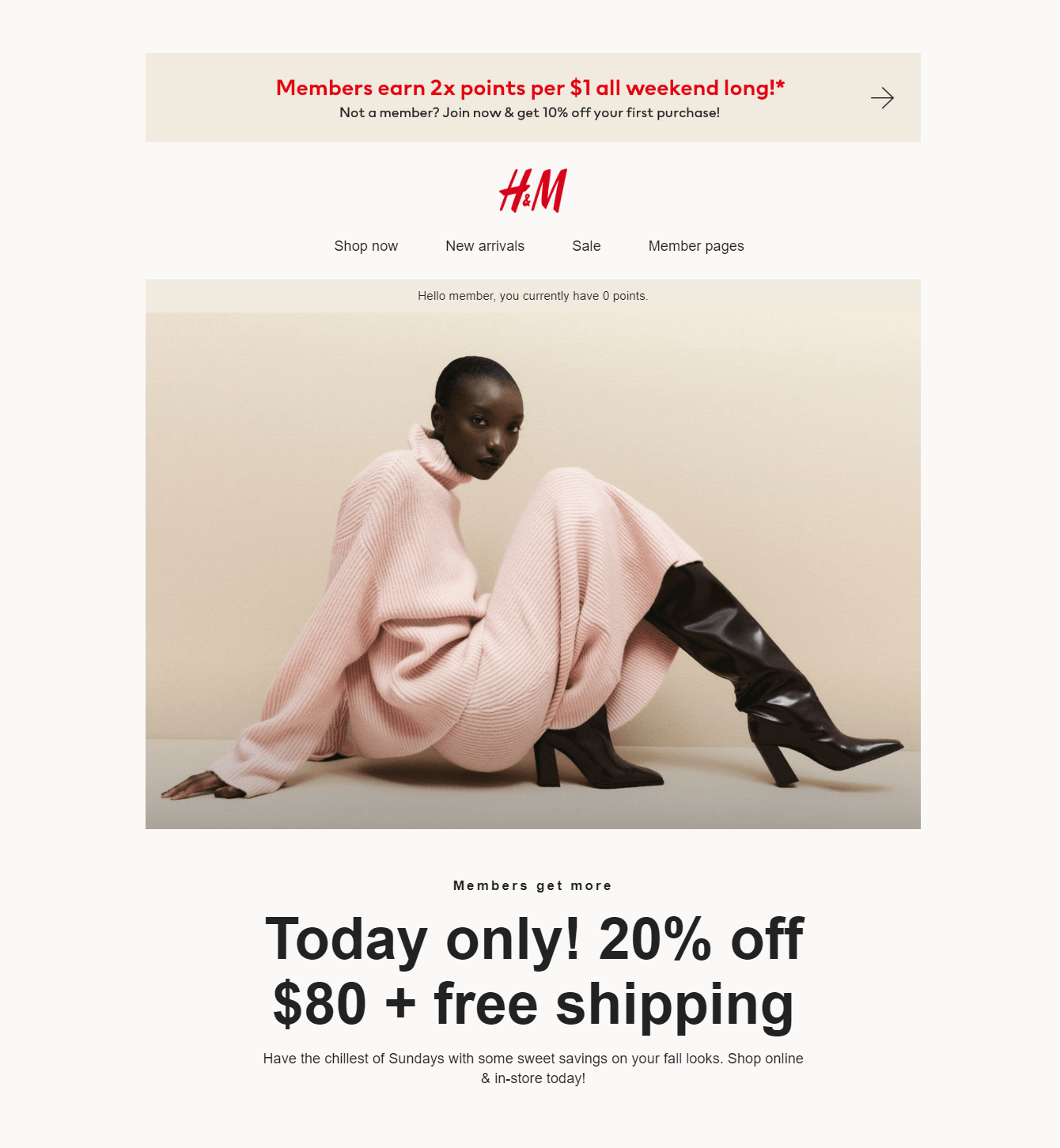
Referral emails can also be a part of a loyalty program. Through it, businesses may offer additional rewards or bonuses for customers who successfully refer new clients.
What to consider:
- Exclusivity: Give your loyalty members limited time offers, early access to sales, and VIP perks available only to members, creating a sense of special value as often as possible.
- Simplicity: Clear and on-point messages and CTAs are easy to read, understand, and act upon, enhancing engagement and CTR rates.
- Minding the metrics: Monitor the performance of the emails through email engagement metrics. Use this data to refine future campaigns and improve results.
Diversify Your Email Marketing Strategy
Using different campaign types will strengthen your relationship with your audience, increase the value of your brand, and bring you profit.
To simplify the process, you can follow email best practices and use reliable email marketing software to set up, create, deliver, and track their performance.
Apart from great email deliverability and flexible automation, Moosend offers email templates for different email types that greatly speed up the email design and creation process. You can take advantage of their responsiveness and customizability to craft on-brand campaigns fast and easy.
If you want to give them a go, you can sign up for the 30-day free trial and start building your next campaign in a few minutes.
